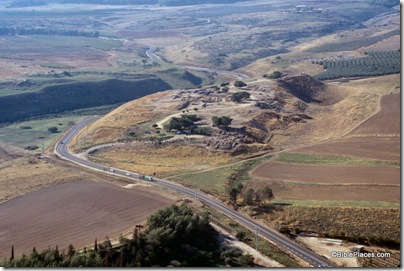Gordon Franz has posted a review of his experience excavating at Hazor this summer. He considers it “the most pleasant, productive, and interesting season” of his eight years on the team. Some excerpts:
One important discovery this season made the international press: two fragments of a Middle Bronze legal tablet written in Akkadian and contemporary with, and similar to, the famous Hammurabi’s law code.
Robert Cargill asked the question on his blog: “Where was this in 2006 when I was digging there? lol.” The answer is quite simple: “Right under your feet where you were sitting during tea break at 7 AM every morning!” This discovery by the eagle-eyed conservator at Hazor, Orna Cohen, was made on the surface and not in the actual stratified excavation.
[…]
Another important discovery that will probably not make the international press is an Iron Age basalt workshop that was found in Area M. It was the first time in the archaeology of the Middle East that such a discovery was made….In the weeks that followed, I sifted much of the material from the floor of this workshop, saving the basalt chips, pottery, and organic matter. I also found an iron chisel. The excavation’s basalt expert, Jenny, will have plenty of material to study and analyze in order to understand the process of making basalt objects. Basalt is one of the hardest stones, which makes it difficult to work. It will be interesting to see whether the lab results show that the iron chisel had been tempered and made into steel. If so, that would go a long way in explaining how basalt was worked. Moreover, geological tests can be done to determine the basalt’s source.
[…]
One of the projects carried out by Orna Cohen and the Druze workers this summer was the reconstruction of part of the casemate wall near the Solomonic Gate. The Druze see themselves as the descendents of the Phoenicians and Hiram’s, king of Tyre, stone masons. They reconstructed the walls using the same techniques as Solomon’s workers: stone upon stone, and without the use of cement.
[…]
By the end of the 2009 season, we had removed most of the eighth-century walls and strata. At the beginning of this season, we spent the first week finishing that job. The next level of occupation was the ninth-century. I thought it would take a season to excavate the remains from that period. We blew through it in a couple of weeks. Area M is outside the Solomonic city so there were no tenth-century domestic dwellings outside the city. Thus we began to penetrate down to the Late Bronze Age palace. By the end of the season, we were on top of the palace and some monumental stones were beginning to appear.
It is in Area M that Dr. Sharon Zuckerman has suggested that the administrative palace of Hazor was and the Canaanite archive of the Late Bronze level would be located (2006: 28-37). When the archive(s) are found at Hazor, it/they will be a major contribution to Biblical studies and go a long way to resolve some of the thorny issues in Biblical Archaeology.
Several blogs have inaccurately reported that the MB tablet was found in the excavations above the palace in Area M, but Franz states that it was found on the surface of the tell west of Area M.
Franz’s full report is here.

One thought on “Franz’s Reflections on Hazor 2010”
That is interesting about the basalt workshop, but I wonder what Gordon meant by "the first time in the archaeology of the Middle East that such a discovery was made." He must be referring to the types of objects that were produced in the workshop. There is a basalt quarry and sculpture workshop at Yesemek that dates from the end of the Hittite empire period and into the Neo-Hittite period. Several hundred unfinished pieces of basalt sculpture were excavated at Yesemek and are on display in an open-air museum.